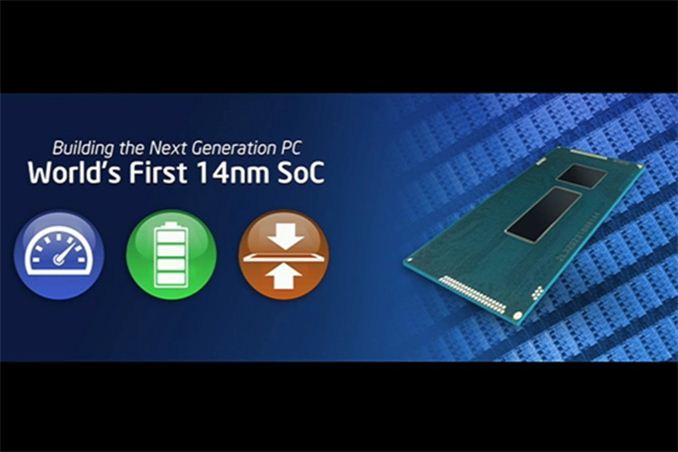Intel 14nm Progress Update: Broadwell & Airmont On Schedule
by Ryan Smith on September 10, 2013 2:45 PM EST
Continuing our IDF 2013 keynote coverage, Intel is also using this morning’s keynote to announce progress updates on previously announced 14nm products. Intel’s plans here remain unchanged, with Intel seeing the exploitation of their fabrication advantages being one of the keys to better capturing the various mobile market segments, so Intel’s progress on their 14nm process and the resulting parts remains as something worth keeping an eye on.
First and foremost with Broadwell, Intel has confirmed that they are beginning 14nm production by the end of this year, with Broadwell being the lead product for the process. We expect to get some additional details on Broadwell later this week in other sessions, but Intel did make quick note of the fact that they’re seeing significant power savings with 14nm Broadwell over 22nm Haswell. Specifically Intel is already seeing a “30 percent power improvement” on battery longevity over Haswell with their early Broadwell silicon (being demoed at the show), with at least some expectation that they’ll see further improvements as they approach release quality silicon.
Meanwhile Intel has also reiterated that they will be following through on their earlier plans to accelerate Atom product releases to move from Intel’s n+1 node to their leading edge node, bringing Atom to parity with their desktop/mobile Core processors. To that end Airmont, Silvermont’s 14nm successor, is still slated for a 2014 release. The move from trailing nodes to leading nodes for Atom SoCs is perhaps the biggest sign of how Intel is treating the tablet/smartphone market this days, with the market being elevated from a secondary market to a primary market that receives (nearly) equal access to Intel’s latest fabrication technology, and by extension being a market that requires Intel’s most competitive products.
Source: The Verge











36 Comments
View All Comments
extide - Wednesday, September 11, 2013 - link
I doubt you will see a 30% gain in efficiency at full load, that is probably quoted during a 'tpical use' load, which will include lots of idle time, and thus clock gating/etc.lefty2 - Tuesday, September 10, 2013 - link
Considering how the PC market is in a downward spiral, I wonder if it's wise to have such massive capital spending on new nodes. They already had to delay the Irish 14nm fab because of lack of demand.kyuu - Tuesday, September 10, 2013 - link
PC market isn't in a "downward spiral". It's stagnant, which is quite a bit different.Also, if you didn't notice they're using the new nodes for mobile-focused SoCs, and making their desktop/laptop parts more power-efficiency focused in order to put them into smaller and more mobile platforms.
lefty2 - Tuesday, September 10, 2013 - link
IDC says it's down 7% - 10% this year. I think eventually it'll pick up, but I still don't think now is the time to be burning captial on new process for chips that no one's buying.It's good that they finally have Atom SoCs on 22nm, but the margin for tablet SoCs is quite low - nowhere near the 60% they are used to. It won't make up for the slack in the PC market.
jljaynes - Tuesday, September 10, 2013 - link
IDC data does have PC data down this year, but then flat-ish beginning next year IIRC. The key is if they have to revise it down or not. And they still have the desktop market pegged at 134M units a year, and AFAIK IDC only tracks vendor shipments. Jon Peddie Research tracks gaming hardware if you're looking for that kind of data.http://www.idc.com/getdoc.jsp?containerId=prUS2429...
CyberAngel - Wednesday, September 11, 2013 - link
Either way going to 14nm AND deploying the 450mm wafers cuts down the cost of a single chip and that is welcome!lefty2 - Wednesday, September 11, 2013 - link
It does not say that at all. You obviously didn't even read the report that you linked to."The market as a whole is expected to decline through at least 2014, with only single-digit modest growth from 2015 onward, and never regain the peak volumes last seen in 2011."
chizow - Tuesday, September 10, 2013 - link
This doesn't offer complete clarity about some conflicting roadmaps stating Broadwell would be pushed on the desktop and replaced by Haswell refresh. The statement about Broadwell's power saving features at 14nm indicate to me it may still launch in the mobile space, but Haswell refresh will be the desktop parts for 2014.dlder - Wednesday, September 11, 2013 - link
Does anyone know (seen a slide or something), when we'll see 8core Intel CPUs? And I mean for the High End market, not those "E" types, where the tech is like 2 years old. As it's gonna be with Haswell-E, which is coming fall 2015, right?Casper42 - Wednesday, September 11, 2013 - link
Intel doesn't feel the desktop/mobile market wants or needs that. So no, its not gonna happen anytime soon. Lots of new stuff just dropped from Intel and it will be at least 6-12 months before this changes.Case in point, For the Server Market, Intel just released:
Ivy EP with up to 12c per CPU
Avoton (Atom) with up to 8 cores for the Microserver market (Moonshot, SeaMicro, etc)
Meanwhile Haswell Desktop is still only 4 cores and Ivy E maxes out at 6 even though its VERY similar to Ivy EP which can go to 12.